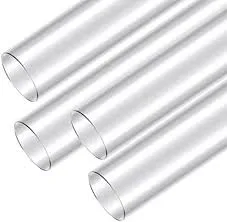Aug . 22, 2024 05:32 Back to list
Clear PVC Tubing for Versatile Applications in Plumbing and Electrical Projects
Understanding Transparent PVC Pipe Versatility and Applications
Transparent PVC pipes have gained significant attention across various industries due to their unique properties and versatile applications. PVC, or polyvinyl chloride, is a widely used thermoplastic that offers both durability and flexibility. When manufactured in its transparent form, PVC pipes provide not only structural integrity but also a visual element that can be advantageous in many scenarios.
One of the primary benefits of transparent PVC pipes is their ability to allow for easy inspection of flow and contents. This transparency aids in monitoring the movement of fluids, making it an ideal choice for applications in laboratories, aquariums, and even certain commercial settings where the visibility of the substance flowing through the pipe is critical. This feature becomes essential in situations where contamination or fluid clarity needs to be assessed without dismantling the system.
Understanding Transparent PVC Pipe Versatility and Applications
In the realm of construction and plumbing, transparent PVC pipes are increasingly being utilized for both drainage systems and water supply lines. Their lightweight nature allows for easy handling and installation, reducing labor costs and installation time. Furthermore, because these pipes do not corrode like metallic counterparts, they can provide a longer-term, maintenance-free solution.
transparent pvc pipe

Ventilation and air systems also benefit from transparent PVC pipes. The visibility factor allows technicians to easily observe airflow and identify blockages or malfunctions within the system without needing to open up or access hard-to-reach sections. This ease of maintenance contributes to improved efficiency and safety in a range of HVAC applications.
Additionally, the aesthetic appeal of transparent PVC cannot be overlooked. In architectural designs, these pipes can be incorporated into visible plumbing or feature elements in homes and businesses without compromising design integrity. Their clean, sleek appearance can blend seamlessly with modern decor, providing functionality while maintaining an attractive look.
Transparent PVC pipes are also utilized extensively in various recreational applications, such as in theme parks for slides or water features, where the appeal of crystal-clear water enhances the overall experience. Similarly, in aquaculture and aquariums, these pipes are crucial for both aesthetics and function, allowing for the transportation of water and nutrients while maintaining visibility to monitor fish and plant health.
Despite their many advantages, it is important to note that transparent PVC pipes also have limitations. They are not recommended for applications involving high-pressure scenarios due to a lower tolerance compared to other materials like metal or certain reinforced plastics. Care must be taken when selecting the right type of pipe for specific needs.
In conclusion, transparent PVC pipes represent a fascinating intersection of functionality, safety, and aesthetics. Their diverse applications across multiple sectors—from industrial processes and plumbing solutions to recreational uses—underscore their importance in modern engineering and design. As industries continue to evolve, the demand for such versatile materials is likely to grow, driving further innovations in this field.
-
PVC Transparent Sheet Roll - Durable & Flexible PVC Plastic Sheet Roll for Industrial & Home Use
NewsJun.24,2025
-
High-Quality PVC PPR Pipes and Fittings Durable ERA PPR Solutions
NewsJun.10,2025
-
High-Quality Large HDPE Sheets & Large Diameter PVC Pipe Durable Large PVC Pipe Supplier
NewsJun.10,2025
-
High Density Polyethylene Cutting Board - Durable & Food Safe
NewsJun.09,2025
-
3 Inch PVC Pipe for Durable Irrigation Affordable & Reliable
NewsJun.09,2025
-
Premium PPR Plastic Water Pipe Fittings - Durable & Leak-Free
NewsJun.09,2025

